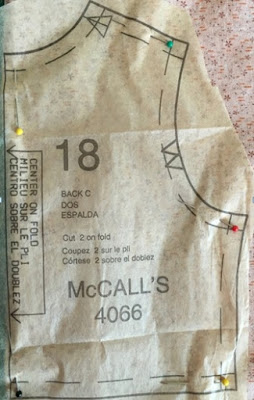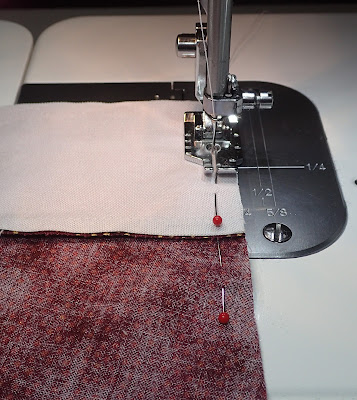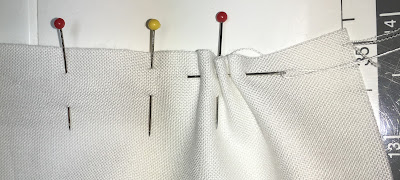On Pins and Needles Part 1
Are you “on pins and needles†when it comes to, well, pins and needles? Do you give them any thought at all? They’re our smallest tool but have the most important
job. Without pins holding our fabrics in place, we’d have a terrible time creating our lovely projects.
Â
left to right: metal, pearl, glow in the dark,
plastic ball, no-melt flat, glass, quilting
plastic ball, no-melt flat, glass, quilting
When we head to the store to purchase pins the first thing we’re often drawn to is
the wonderful colors and fun shapes. But to find the correct pin for the task, you’ll
need to consider the pin’s anatomy and the project you’re working on.
the wonderful colors and fun shapes. But to find the correct pin for the task, you’ll
need to consider the pin’s anatomy and the project you’re working on.
Anatomy of the pin
Head should be picked based on the sewing task.
- Metal Flat Head: Small solid metal pin. Great
for handwork and pinning appliqué pieces. - Plastic Ball: Colored ball, pearl, and glow
in the dark. Sized for many different purposes. Plastic ball may melt if
pressed with high heat. - No-Melt Plastic Flat Head: Extra long, fine
pin with a flat head for eyelet, lace, lofty and loose woven fabrics. - Glass Ball: Thinner, sharper pin with a glass
head that won’t melt. - Quilting: Longer pin for holding thick layers.
Shaft diameter should not leave large holes in your fabrics.
- .5mm – fine to lightweight fabrics
- .6mm – medium-weight fabrics
- .7mm to .8mm – medium to heavy fabrics
Shaft length should provide ease of handing for your project.
           Short: 1/2†– 7/8†for detailed handwork and close pinning on appliqué and trims
           Medium: 1 1/16†– 1 5/16†for multipurpose work
           Long: 1 1/2†– 2†for quilting and thick layers
Point should glide easily through the fabric without snagging the threads.
           Sharp for most woven fabrics.
           Ball Point is slightly rounded for knits.
Proper Way to Pin
Oops, I could have “heard a pin drop†after that headline. How to pin will often
trigger a debate much like “to wash or not to wash†fabric.
trigger a debate much like “to wash or not to wash†fabric.
In class, I teach pinning parallel in the seam allowance when cutting a pattern.
Pins will be close to the cutting line, but you won’t accidentally hit them and
ruin your expensive scissors.
Pins will be close to the cutting line, but you won’t accidentally hit them and
ruin your expensive scissors.
Pinning perpendicular for machine sewing works best. The fabric lays nicer, the pin can
be placed right where it’s needed, you can sew right up to the pin before removing it, pins are easy to see and pull out, and if you accidentally miss a pin chances are it will clear the machine needle.
be placed right where it’s needed, you can sew right up to the pin before removing it, pins are easy to see and pull out, and if you accidentally miss a pin chances are it will clear the machine needle.
If you were to pin parallel for machine sewing you wouldn’t be able to sew close
enough to the pinned seams before removing the pin. This would leave too much
of a chance that the seams will shift before being sewn.
enough to the pinned seams before removing the pin. This would leave too much
of a chance that the seams will shift before being sewn.
Pinning perpendicular for hand sewing allows the fabric to gather nicely in your hand.
The pins fall gently into the folds of the fabric with less chance of stabbing you.
The pins fall gently into the folds of the fabric with less chance of stabbing you.
“To the Pointâ€
- Always toss out dull or bent pins.
- Never sew over pins.
- Don’t leave a pin in the fabric for long periods of time. This will create permanent holes.
Pin Worthy Fun
Until we meet again, I’ll leave you with a bit of fun. I think you’ll be amazed at how graphic designer Christophe Thockler used his pins and thread for this VIDEO!
Favorite Place by Black Books
http://christophethockler.com/music-video-black-books-favorite-place.html
  Always sew for fun!
Carol Steely, FunThreads Designs
Carol Steely, FunThreads Designs









I recently purchased some pins for my project and the heads keep falling off the pin , i wrote the company and i was shocked to never even get a email saying sorry from the company . out of 400 pins im saying the least to loose their heads was 75 maybe even more i have a few i have not used yet . how would you handle this if a product that you paid good money for was very flawed ? pyrm i thought was a great product !
Mary,
For starters, I would do what you did – write, to give them a chance to make recompense. I believe in making your voice heard whenever any product falls short. When they don’t respond, see if they have a website, where you can “review” a specific product. It isn’t the price that you paid, as much as the principle in trusting a company’s reputation for a quality product. If you still want to, you can try to call them & let them know you’ll be telling everyone you know – friends, quilting groups/ membership websites, etc. 75 lost heads on pins is more than an aggravation – quality control is certainly lacking. How are they going to know that quality is important if no one says anything? At the end of the day, you could try gluing them back on with super-glue or separate them out for use in DIY projects.
I was quilting with my mother last weekend and the pins she purchased all had dull points. I told her to toss them and buy new ones. They were miserable to work with and it was totally worth it to spend a few dollars on sharp pins.
I love collecting pins…….and pin cushions.
Pingback: On Pins and Needles! | Silver Threads Quilt Guild